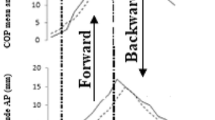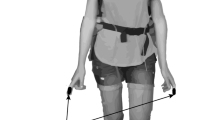Abstract
Whereas working under constrained postures is known to influence the worker’s perceived comfort and health, little is known in regard to its influence on performance. Employing an Auditory Simon task while varying posture, we investigated the relationship between constrained postures and cognitive processes in three experiments. In Experiment 1 and 2, participants operated a rocker switch or a control knob with one hand either in front or in the back of their body and while either sitting or kneeling. Perceived musculoskeletal exertion was gathered with a questionnaire. Results of the first two experiments showed differently perceived comfort and a minor effect of constrained posture on cognitive performance. However, results indicated that spatial coding in the back compares to either a virtual turn of the observer towards the control device (front-device coding) or along the observer’s hand (effector coding). To clarify this issue the rocker switch was operated with one or two hands in Experiment 3, showing a comparable coding only in the one-hand condition and indicating evidence for the effector-coding hypothesis in the back.



Similar content being viewed by others
Notes
References
Beermann, B., Brenscheidt, F., & Siefer, A. (2005). Arbeitsbedingungen in Deutschland—Belastungen, Anforderungen und Gesundheit. Dortmund: Bundesanstalt für Arbeitsschutz und Arbeitsmedizin.
Bhatnager, V., Drury, C. G., & Schiro, S. G. (1985). Posture, postural discomfort, and performance. Human Factors, 27, 189–199.
Borg, G. (1982). Psychophysical bases of perceived exertion. Medicine and Science in Sports and Exercise, 14, 377–381.
Brainard, D. H. (1997). The psychophysics toolbox. Spatial Vision, 10, 433–436.
Bundesministerium für Arbeit und Soziales (BMAS), & Bundesanstalt für Arbeitsschutz und Arbeitsmedizin (BAuA). (2009). Sicherheit und Gesundheit bei der Arbeit 2009, Unfallverhütungsbericht Arbeit. Berlin: Bundesanstalt für Arbeitsschutz und Arbeitsmedizin.
Cho, D. T., & Proctor, R. W. (2010). The object-based Simon effect: grasping affordance or relative location of the graspable part? Journal of Experimental Psychology: Human Perception and Performance, 36, 853–861.
DIN EN ISO 9241-9 (2000). Ergonomic requirements for office work with visual display terminals (VDTs)—Part 9: Requirements for non-keyboard input devices.
Fabbri, M., Martoni, M., Esposito, M. J., Brighetti, G., & Natale, V. (2006). Postural control after a night without sleep. Neuropsychologia, 44, 2520–2525.
Guiard, Y. (1983). The lateral coding of rotations: a study of the Simon effect with wheel-rotation responses. Journal of Motor Behavior, 15, 331–342.
Haslegrave, C. M. (1994). What do we mean by a ‘working posture’? Ergonomics, 37, 781–799.
Heister, G., Ehrenstein, W. H., & Schroeder-Heister, P. (1987). Spatial S-R compatibility with unimanual two-finger choice reactions: effects of irrelevant stimulus location. Perception and Psychophysics, 42, 195–201.
Hommel, B. (1994). Spontaneous decay of response-code activation. Psychological Research, 56, 261–268.
Hommel, B. (1996). S-R compatibility effects without response uncertainty. The Quarterly Journal of Experimental Psychology, 49, 546–571.
Hünting, W., Läubli, T. H., & Grandjean, E. (1981). Postural and visual loads at VDT workplaces I. Constrained postures. Ergonomics, 24, 917–931.
Janczyk, M. (2013). Level 2 perspective taking entails two processes: evidence from PRP experiments. Journal of Experimental Psychology: Learning, Memory, and Cognition, 39, 1878–1887.
Kessler, K., & Thomson, L. A. (2010). The embodied nature of spatial perspective taking: embodied transformation versus sensorimotor interference. Cognition, 114, 72–88.
Kimura, K., Imanaka, K., & Kita, I. (2002). The effects of different instructions for preparatory muscle tension on simple reaction time. Human Movement Science, 21, 947–960.
Liao, M.-H., & Drury, C. G. (2000). Posture, discomfort and performance in a VDT task. Ergonomics, 43, 345–359.
Loftus, G. R., & Masson, M. E. (1994). Using confidence intervals in within-subject designs. Psychonomic Bulletin & Review, 1, 476–490.
Moll, H., & Meltzoff, A. N. (2011). Perspective-taking and its foundation in joint attention. In N. Eilan, H. Lerman, & J. Roessler (Eds.), Perception, causation, and objectivity. Issues in philosophy and psychology (pp. 286–304). Oxford: Oxford University Press.
Murchison, N. M., & Proctor, R. W. (2013). Spatial compatibility effects with unimanual and bimanual wheel-rotation responses: an homage to Guiard (1983). Journal of Motor Behavior, 45, 441–454.
Müsseler, J., Koch, I., & Wühr, P. (2005). Testing the boundary conditions for processing irrelevant location information: the cross-task Simon effect. European Journal of Cognitive Psychology, 17, 708–726. doi:10.1080/09541440540000068.
Müsseler, J., Wühr, P., & Umiltá, C. (2006). Processing of irrelevant location information under dual-task conditions. Psychological Research, 70, 459–467. doi:10.1007/s00426-005-0010-x.
Nag, A., Vyas, H., Shah, P., & Nag, P. K. (2012). Risk factors and musculoskeletal disorders among women workers performing fish processing. American Journal of Industrial Medicine, 55, 833–843.
Pelli, D. G. (1997). The VideoToolbox software for visual psychophysics: transforming numbers into movies. Spatial Vision, 10, 437–442.
Pfister, R., & Janczyk, M. (2013). Confidence intervals for two sample means: calculation, interpretation, and a few simple rules. Advances in Cognitive Psychology, 9, 74–80.
Proctor, R. W., Miles, J. D., & Baroni, G. (2011). Reaction time distribution analysis of spatial correspondence effects. Psychonomic Bulletin & Review, 18, 242–266.
Proctor, R. W., & Vu, K.-P. L. (2006). Stimulus-response compatibility principles: data, theory, and application. Boca Raton: Taylor & Francis Group.
Roswarski, T. E., & Proctor, R. W. (2000). Auditory stimulus-response compatibility: is there a contribution of stimulus-hand correspondence? Psychological Research, 63, 148–158.
Sanders, A. F. (1980). Some effects of instructed muscle tension on choice reaction time and movement time. In R. S. Nickerson (Ed.), Attention and performance VIII (pp. 59–74). Hillsdale: Erlbaum.
Sanders, A. F. (1998). Elements of human performance: reaction processes and attention in human skill. Mahwah: Erlbaum.
Shiu, L. P., & Kornblum, S. (1999). Stimulus-response compatibility effects in go-no-go tasks: a dimensional overlap account. Perception & Psychophysics, 61, 1613–1623.
Simon, J. R. (1990). The effects of an irrelevant directional cue on human information processing. In R. W. Proctor & T. G. Reeve (Eds.), Stimulus-response compatibility: an integrated perspective (pp. 31–86). Amsterdam: North-Holland.
Simon, J. R., & Rudell, A. P. (1967). Auditory S-R compatibility: the effect of an irrelevant cue on information processing. Journal of Applied Psychology, 51, 300–304.
Simon, J. R., & Small, A. M. (1969). Processing auditory information: interference from an irrelevant cue. Journal of Applied Psychology, 53, 433–435.
Spijkers, W. A. (1990). The relation between response-specificity, S-R compatibility, foreperiod duration and muscle-tension in a target aiming task. Acta Psychologica, 75, 262–277.
Spilling, S., Eitrheim, J., & Åaras, A. (1986). Cost-benefit analysis of work environment investment at STK’s telephone plant at Kongsvinger. In N. Corlett, J. Wilson, & I. Manenica (Eds.), The ergonomics of working postures (pp. 380–397). London: Taylor & Francis.
Teasdale, N., Bard, C., LaRue, J., & Fleury, M. (1993). On the cognitive penetrability of posture control. Experimental Aging Research, 19, 1–13.
Wallace, R. J. (1971). S-R compatibility and the idea of a response code. Journal of Experimental Psychology, 88, 354–360.
Wang, D.-Y. D., Proctor, R. W., & Pick, D. F. (2003). The Simon effect with wheel-rotation responses. Journal of Motor Behavior, 35, 261–273.
Wascher, E. (2005). The timing of stimulus localisation and the Simon effect: an ERP study. Experimental Brain Research, 163, 430–439.
Wickens, D. C., Lee, J. D., Liu, Y., & Becker, S. E. G. (2004). Human factors engineering. New Jersey: Pearson.
Worringham, C. J., & Beringer, D. B. (1989). Operator orientation and compatibility in visual-motor task performance. Ergonomics, 32, 387–399.
Worringham, C. J., & Beringer, D. B. (1998). Directional stimulus-response compatibility: a test of three alternative principles. Ergonomics, 41, 864–880.
Acknowledgments
We would like to thank Markus Janczyk, Robert Proctor, and Bernhard Hommel for their valuable and constructive comments on an earlier version of the manuscript. Correspondence concerning this article should be addressed to either author at the Institute of Psychology, RWTH Aachen University. Email: kreutzfeldt@ or muesseler@psych.rwth-aachen.de.
Author information
Authors and Affiliations
Corresponding author
Rights and permissions
About this article
Cite this article
Kreutzfeldt, M., Leisten, M. & Müsseler, J. Constrained postures and spatial S–R compatibility as measured by the Simon effect. Psychological Research 79, 658–668 (2015). https://doi.org/10.1007/s00426-014-0601-5
Received:
Accepted:
Published:
Issue Date:
DOI: https://doi.org/10.1007/s00426-014-0601-5




